AMBOSELI MOBILE VETERINARY UNIT SENSITIZATION PROGRAMME MAY 2014 Summary The Amboseli veterinary unit was launched on the 30th April 2014 at the KWS headquarters
AMBOSELI MOBILE VETERINARY UNIT SENSITIZATION PROGRAMME MAY 2014
Summary
The Amboseli veterinary unit was launched on the 30th April 2014 at the KWS headquarters. The team comprising of one veterinary doctor, two rangers and a driver then left for Amboseli National park (operation base) and embarked on a sensitization programme in the Southern Conservation area. This was intended to notify the KWS personell and stakeholders in the area that the veterinary services had been brought closer. The programme involved visits within the region. Areas visited included: Chyullu National Park, Kiboko post, Tsavo West National Park, Kimana sanctuary, Biglife foundation, Living with lions, Kuku ranch, Ngulia rhino headquartes, Mukururo rhino headquarters, The David Sheldrick Wildlife trust, Kaluku, Tsavo Mobile Veterinary unit, Lodges witin Tsavo West National Park, Lodges wthin Amboseli National Park, Predator compensation base in Amboseli National Park, Amboseli baboon research, Kajiado region, Namanga, Lion guard, Kitirua operation base, KWS Taveta station, Maktau station, Njukini post, Rombo station, Loitokitok station, and Osewan. A radio message was also circulated to all KWS Southern Conservation area offices for detailed information. This was carried out hand in hand with immediate response clinical interventions.
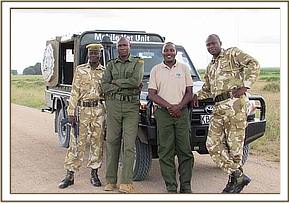

Case #1 Injured elephant:
Date: 14th May 2014
Species: Elephant
Sex: Male
Location: Serera Lodge Junction
G.P.S position: 306520, 9702580
History:
An elephant was reported to have been immobile though had been earlier treated. The veterinary team attended to the case and made a decision to dart the animal for closer observation.
Immobilization:
The elephant was immobilized using 16 mgs Etorphine Hydrochloride in a 2cc dart toped up using water for injection. Darting from a vehicle was done using Dan-inject system. Full immobilization took place after 7 minutes and she fell on lateral recumbence. The trunk was maintained patent by the help of a piece of stick which was placed across at their’ entrances. The ears were used as blindfold.
Examination and Treatment:
On physical examination the elephant had a penetrating wound on the left fore limb . The wound had pus and dead tissue. Proximal to the wound there was a scar of the wound that had been previously treated and healed by granulation. The wound was probed for any foreign body and there was none. It was thoroughly cleaned using water and Hydrogen Peroxide then lavaged using tincture of Iodine. The bull was injected with 100 ml oxytetracycline 20% and 50 ml Dexamethasone at different sites intramuscularly. Topical antibiotic ointment and grey clay was then applied on the wound to facilitate healing. The operation lasted 10 minutes.
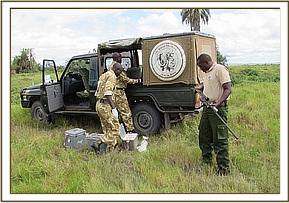
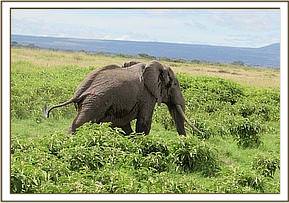




Reversal of immobilization:
Diprenorphine Hydrochloride (48mgs) into the ear vein was used. It took 10 minutes to be fully awake from the anesthesia.
Prognosis: Prognosis is good.
Futher Examination:
One week later, the elephant could use the four limbs and without much difficulty. Retreatment has been done again and great signs of improvement have been noted.

Case #2 Treatment of elephant with a tongue wound:
Date: 19th May 2014
Species: Elephant
Sex: Male
Location: Iremito Gate - Amboseli
G.P.S position: 37m0318485, Utm9697641 History:
A male elephant was reported to have been spotted off feed and reluctant to move for one day. It was also unthrifty and had experienced loss of body condition. A decision was made to immobilize the elephant after arrival and observing the elephant.
Immobilization:
The elephant was immobilized using 16 mgs Etorphine Hydrochloride in a 2cc dart toped up using water for injection. Darting from a vehicle was done using Dan-inject system. Full immobilization took place after 7 minutes and she fell on lateral recumbence. The trunk was maintained patent by the help of a piece of stick which was placed across at their’ entrances. The ears were used as blindfold.
Examination and Treatment:
On physical examination the elephant had a penetrating wound on the tongue likely to have occurred while feeding. There was also pus and dead tissue. The wound was probed for any foreign body and there was none. It was thoroughly washed using clean water and Hydrogen Peroxide then lavaged using tincture of Iodine. The bull was injected with 100 ml oxytetracycline 20% and 50 ml Dexamethasone at different sites intramuscularly. Topical antibiotic ointment was then applied on the wound to facilitate healing. The operation lasted 25 minutes.
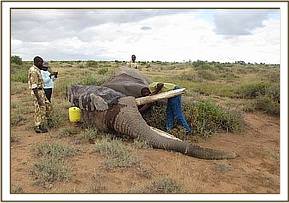
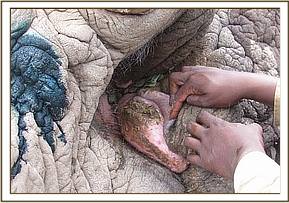


Reversal of immobilization:
Diprenorphine Hydrochloride (48mgs) into the ear vein was used. It took 7minutes to be fully awake from the anesthesia.
Prognosis: Prognosis is good.
Case #3 Post Mortem Report on a adult elephant:
Date of Autopsy: 16th May 2014
Species: Elephant
Sex: Male
Age: 45- 50 years
Location: Kimana sanctuary (Amboseli ecosystem)
GPS: 037m 0340488, UTM 9696856
History:
An elephant carcass was seen on 15-04-2014 at day time around 6.00 pm by KWS and Kimana sanctuary security personnel while on their normal daily routine patrol.
General post mortem findings:
The elephant was on lateral recumbence position adjacent to a huge tree which had probably provided support and a shade prior to death. Large maggots were present and the carcass had decomposed.Both elephant tusks were present:
The KWS security personnel removed the tusks with ease suggesting that the elephant had died 2-3 weeks prior to being sighted.
On physical examination, no physical injury was observed.
Procedure:
The KWS security personnel removed the tusks and delivered them to Amboseli National park head quarters for safe custody. The tusks were weighed prior to storage and weighed 33 kg and 20kg. Cause of death Taking into consideration: -The period that the carcass was in the sanctuary and the tusks were intact. -No physical injury observed -The age of the elephant. -The elephant could have died a natural death out of old age.
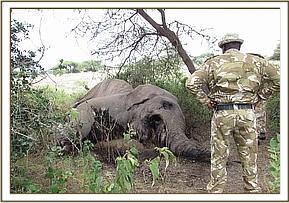
Case #4 Treatment of an elephant:
Date: 20th May 2014
Species: Elephant
Sex: Male
Location: Ngulia
G.P.S position: 0424273, 9674466
History:
An elephant was reported to have been immobile though had been treated 10 days earlier. The veterinary team attended to the case in Ngulia and made a decision to dart the animal for closer observation and further treatment to increase chances of survival.
Immobilization:
The elephant was immobilized using 17 mgs Etorphine Hydrochloride in a 3cc dart toped up using water for injection. Foot darting Dan-inject system was deployed since the terrain could not allow easy maneuvering of the vehicle. Full immobilization took place after 12 minutes and she fell on lateral recumbence. The trunk was maintained patent by the help of a piece of stick which was placed across at their’ entrances. The ears were used as blindfold.
Examination and Treatment:
On physical examination the elephant had a penetrating wound on the left fore limb . The wound had pus and dead tissue.The wound was probed for any foreign body and there was none. About 500ml of pus gushed out of the wound. The wound was about 20 cm deep and could have been as a result of a gunshot. The entire limb was also swollen and the skin around the wound was necrotic. It was thoroughly cleaned using water and Hydrogen Peroxide then lavaged using tincture of Iodine. The bull was injected with 200 ml oxytetracycline 20% and 100 ml Flunixine Meglumine at different sites intramuscularly. Topical antibiotic ointment and grey clay was then applied on the wound to facilitate healing. The operation lasted 30 minutes.
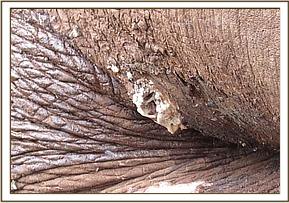
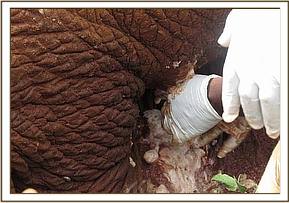
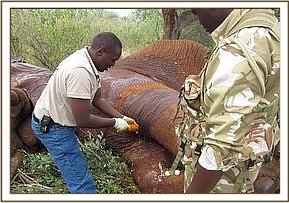
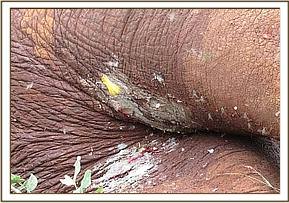

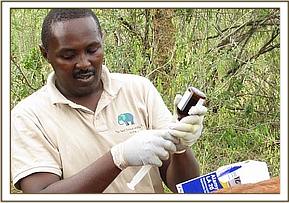

Reversal of immobilization:
Diprenorphine Hydrochloride (48mgs) into the ear vein was used. It took 8 minutes to be fully awake from the anesthesia.
Prognosis: Prognosis is good.
Case #5 Post mortem on a giraffe:
Date: 26th May 2014
Species: Giraffe
Sex: Male Location: Ose wan - Amboseli National Park
G.P.S position: 37m0318503, Utm9697486
History:
The giraffe was spotted dead by game scouts on the previous evening. Post mortem was done after after about 18 hours.
Post Mortem findings:
The neck region, left fore and hind limbs had been severed by predators or humans after death of the giraffe. The carcass was dehydrated and had a matted hind quarter. There were flank blood tints from the anus. On opening the carcass there was a lot of echmotic hemorrhage on the gut walls. The liver had a coked appearance and swollen. The entire G.I.T system had bloody fluid and very little feacal material. There was blood tinted ingesta in the abomasum and paintbrush hemorrhage in the rectum, colon and illum. There was hemorrhage and congested blood vessels in the serosa.The illium and distal colon had flank blood.
Cause of Death:
Severe bacterial gastroenteritis, leading to hypovolemic shock due to excess fluid loss. Blood samples were collected to establish the type of infection and eliminate anthrax.



Conclusion:
The Amboseli mobile veterinary unit is grateful to all individuals who played a role in the establishment of this unit geared towards the good of conservation. Many thanks to The David Sheldrick Wildlife Trust, The Samuel J and Ethel Lefrak charitable trust and The Kenya Wildlife Service for their continued support to this unit which aims at immediate response to clinical intervention, wildlife rescues and alleviating wildlife suffering.
Report by: Dr. Michael Njoroge